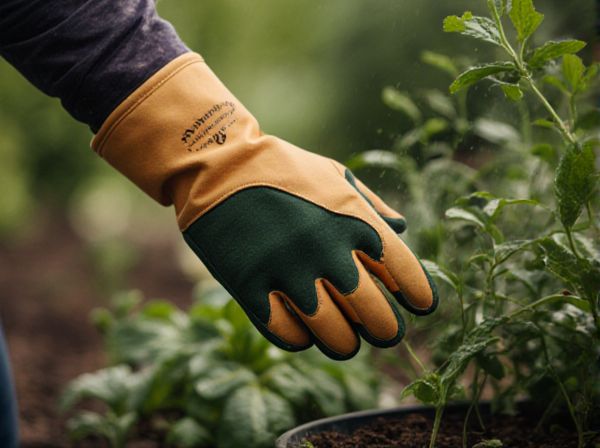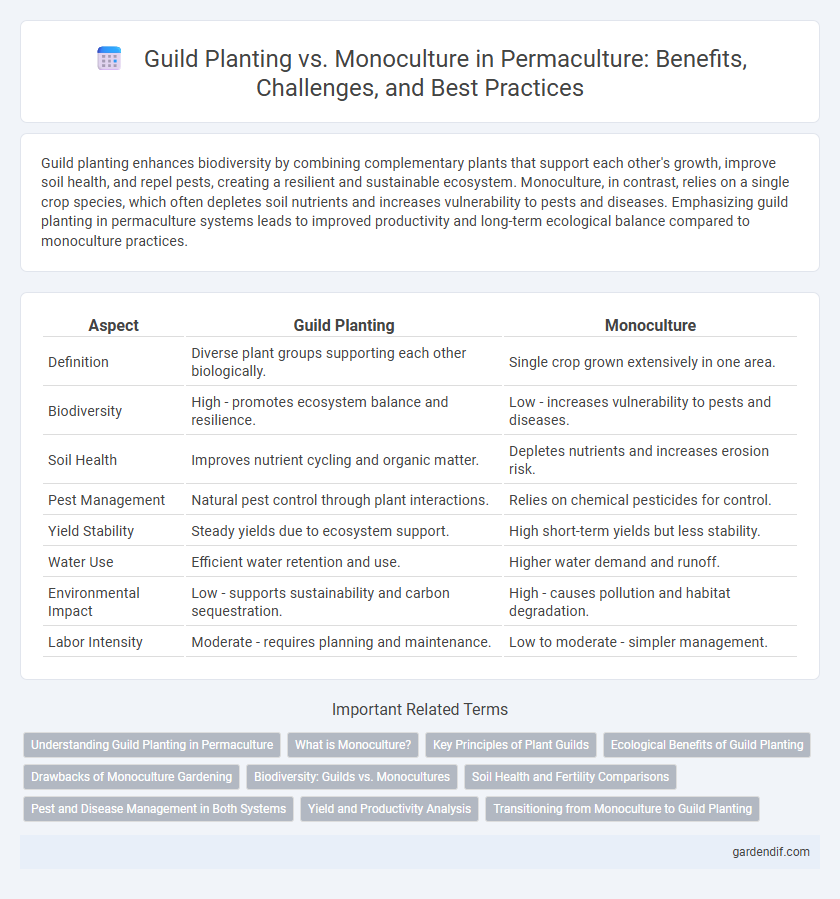
Guild Planting vs Monoculture Illustration
Guild planting enhances biodiversity by combining complementary plants that support each other's growth, improve soil health, and repel pests, creating a resilient and sustainable ecosystem. Monoculture, in contrast, relies on a single crop species, which often depletes soil nutrients and increases vulnerability to pests and diseases. Emphasizing guild planting in permaculture systems leads to improved productivity and long-term ecological balance compared to monoculture practices.
Table of Comparison
| Aspect | Guild Planting | Monoculture |
|---|---|---|
| Definition | Diverse plant groups supporting each other biologically. | Single crop grown extensively in one area. |
| Biodiversity | High - promotes ecosystem balance and resilience. | Low - increases vulnerability to pests and diseases. |
| Soil Health | Improves nutrient cycling and organic matter. | Depletes nutrients and increases erosion risk. |
| Pest Management | Natural pest control through plant interactions. | Relies on chemical pesticides for control. |
| Yield Stability | Steady yields due to ecosystem support. | High short-term yields but less stability. |
| Water Use | Efficient water retention and use. | Higher water demand and runoff. |
| Environmental Impact | Low - supports sustainability and carbon sequestration. | High - causes pollution and habitat degradation. |
| Labor Intensity | Moderate - requires planning and maintenance. | Low to moderate - simpler management. |
Understanding Guild Planting in Permaculture
Guild planting in permaculture involves grouping complementary plants that support each other's growth, enhancing biodiversity and soil health while reducing pests naturally. This method contrasts sharply with monoculture, where a single crop is grown extensively, often leading to soil depletion and increased vulnerability to diseases. By fostering symbiotic relationships among plants such as nitrogen fixers, dynamic accumulators, and pest repellents, guild planting creates resilient ecosystems that improve yield and sustainability.
What is Monoculture?
Monoculture is an agricultural practice that involves growing a single crop species over a large area, often resulting in reduced biodiversity and increased vulnerability to pests and diseases. This method relies heavily on synthetic fertilizers and pesticides to maintain soil fertility and protect crops, leading to environmental degradation and soil depletion. In contrast to guild planting, monoculture systems lack the natural symbiotic relationships between plants, which limits ecosystem resilience and long-term sustainability.
Key Principles of Plant Guilds
Plant guilds in permaculture emphasize diverse species arranged to support each other through complementary functions such as nitrogen fixation, pest control, and nutrient cycling. This polyculture approach fosters resilient ecosystems by enhancing soil health, promoting biodiversity, and improving plant productivity compared to monoculture systems. Key principles include selecting companion plants that fulfill specific ecological roles, optimizing resource use, and creating synergistic relationships within the guild.
Ecological Benefits of Guild Planting
Guild planting enhances biodiversity by combining complementary plant species that support each other's growth and resilience, promoting a self-sustaining ecosystem. This method improves soil health through natural nutrient cycling and pest control, reducing the need for chemical inputs. Compared to monoculture, guild planting increases ecosystem stability, water retention, and habitat diversity, fostering long-term ecological balance.
Drawbacks of Monoculture Gardening
Monoculture gardening reduces biodiversity and increases vulnerability to pests and diseases, leading to higher dependency on chemical pesticides and fertilizers. This practice depletes soil nutrients more rapidly, causing long-term soil degradation and reduced crop yields. In contrast, guild planting enhances ecosystem resilience by promoting symbiotic relationships among diverse plant species, improving soil health naturally.
Biodiversity: Guilds vs. Monocultures
Guild planting enhances biodiversity by combining multiple plant species that support each other's growth, nutrient cycling, and pest resistance, creating a resilient ecosystem. In contrast, monocultures rely on a single crop species, which reduces habitat diversity and increases vulnerability to pests, diseases, and soil degradation. The diverse interactions in guilds promote soil health, attract beneficial insects, and improve overall ecosystem stability compared to the uniformity and ecological risks of monoculture systems.
Soil Health and Fertility Comparisons
Guild planting enhances soil health by promoting biodiversity, which improves nutrient cycling and increases organic matter through complementary plant relationships. In contrast, monoculture depletes soil nutrients rapidly due to repetitive planting of a single crop, often requiring synthetic fertilizers to maintain fertility. Diverse root systems in guilds improve soil structure and microbial activity, leading to sustainable fertility and long-term soil resilience.
Pest and Disease Management in Both Systems
Guild planting enhances pest and disease management by promoting biodiversity, which supports natural predators and reduces the spread of harmful pathogens. Monoculture systems often face higher risks of pest outbreaks and disease due to genetic uniformity and lack of ecological checks. Integrating diverse species in guild planting creates a balanced ecosystem that naturally suppresses pests and improves plant health.
Yield and Productivity Analysis
Guild planting enhances yield and productivity by promoting complementary plant relationships that improve nutrient cycling, pest control, and soil health, resulting in more sustainable and resilient crop systems. Monoculture often achieves higher short-term yields for single crops but suffers from increased vulnerability to pests, diseases, and soil degradation, leading to productivity decline over time. Yield stability and ecosystem services in permaculture guilds make them more efficient and sustainable compared to conventional monoculture systems.
Transitioning from Monoculture to Guild Planting
Transitioning from monoculture to guild planting enhances ecosystem resilience by integrating complementary plant species that support nutrient cycling, pest control, and soil health. Guild planting mimics natural ecosystems, promoting biodiversity and reducing the reliance on chemical inputs compared to monoculture systems dominated by single crops. Implementing diverse plant guilds improves water retention and productivity, making it a sustainable alternative for regenerating degraded agricultural lands.
Guild Planting vs Monoculture Infographic

 gardendif.com
gardendif.com